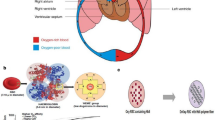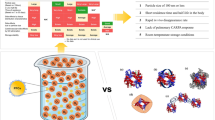Abstract
There is a long history of science seeking to develop artificial substitutes for body parts damaged by disease or trauma. While defective teeth and limbs are commonly replaced by imitations without major loss of functionality, the development of a substitute for red blood cells has proved elusive.
There is a permanent shortage of donor blood in western societies. Nevertheless, despite whole blood transfusions carrying measurable risks due to immunogenicity and the transmission of blood-borne infectious diseases, red blood cells are still relatively inexpensive, well tolerated and widely available. Researchers seeking to develop products that are able to meet and perhaps exceed these criteria have responded to this difficult challenge by adopting many different approaches. Work has focussed on two classes of substances: modified haemoglobin solutions and perfluorocarbon emulsions. Other approaches include the creation of artificial red cells, where haemoglobin and supporting enzyme systems are encapsulated into liposomes.
Haemoglobin is ideally suited to oxygen transport when encased by the red cell membrane; however, once removed, it rapidly dissociates into dimers and is cleared by the kidney. Therefore, it must be stabilised before it can be safely re-infused into humans. Modifications concomitantly alter the vascular half-life, oxygen affinity and hypertensive characteristics of raw haemoglobin, which can be sourced from outdated blood stores, genetically-engineered Escherichia coli or even bovine herds. In contrast, perfluorocarbons are entirely synthetic molecules that are capable of dissolving oxygen but biologically inert. Since they dissolve rather than bind oxygen, their capacity to serve as a blood substitute is determined principally by the oxygen pressure gradients in the lung and at the target tissue.
Blood substitutes have important potential areas of clinical application including red cell replacement during surgery, emergency resuscitation of traumatic blood loss, oxygen therapeutic applications in radiography (oxygenation of tumour cells is beneficial to the effect of certain chemotherapeutic agents), other medical applications such as organ preservation, and finally to meet the requirements of patients who cannot receive donor blood because of religious beliefs.
Given the elite athlete’s historical propensity to experiment with novel doping strategies, it is likely that the burgeoning field of artificial oxygen carriers has already attracted their attention. Scientific data concerning the performance benefits associated with blood substitutes are virtually nonexistent; however, international sporting federations have been commendably proactive in adding this category to their banned substance lists. The current situation is vulnerable to exploitation by immoral athletes since there is still no accepted methodology to test for the presence of artificial oxygen carriers.
Similar content being viewed by others
Notes
1 The use of trade names is for product identification purposes only and does not imply endorsement.
References
Ekblom B, Goldbarg AN, Gullbring B. Response to exercise after blood loss and reinfusion. J Appl Physiol 1972; 33: 175–80
Brien AJ, Simon TL. The effects of red blood cell infusion on 10km race time. JAMA 1987; 257: 2761–5
Buick FJ, Gledhill N, Froese AB, et al. Effect of induced erythrocythemia on aerobic work capacity. J Appl Physiol 1980; 48: 636–42
Parisotto R, Gore CJ, Emslie KR, et al. A novel method utilising markers of altered erythropoiesis for the detection of recombinant human erythropoietin abuse in athletes. Haematologica 2000; 85: 564–72
Lasne F, de Ceaurriz J. Recombinant erythropoietin in urine. Nature 2000; 405: 635
Winslow RM. New transfusion strategies: red cell substitutes. Annu Rev Med 1999; 50: 337–53
Hess JR. Blood substitutes for surgery and trauma: efficacy and toxicity issues. Biodrugs 1999; 12: 81–90
Leone B. Potential clinical applications of recombinant human haemoglobin in blood conservation. Biodrugs 1999; 11: 211–21
Palaparthy R, Wang H, Gulati A. Current aspects in pharmacology of modified hemoglobins. Adv Drug Deliv Rev 2000; 40: 185–98
Reah G, Bodenham AR, Mallick A, et al. Initial evaluation of diaspirin cross-linked hemoglobin (DCLHb) as a vasopressor in critically ill patients. Crit Care Med 1997; 25: 1480–8
Riess JG. Oxygen carriers (‘blood substitutes’): raison d’etre, chemistry, and some physiology. Chem Rev 2001; 101: 2797–920
Vandegriff KD. Haemoglobin-based oxygen carriers. Expert Opin Investig Drugs 2000; 9: 1967–84
Chang TM. Future prospects for artificial blood. Trends Biotechnol 1999; 17: 61–7
Creteur J, Sibbald W, Vincent JL. Hemoglobin solutions: not just red blood cell substitutes. Crit Care Med 2000; 28: 3025–34
Heneka MT, Loschmann PA, Osswald H. Polymerized hemoglobin restores cardiovascular and kidney function in endotoxin-induced shock in the rat. J Clin Invest 1997; 99: 47–54
Lamy ML, Daily EK, Brichant JF, et al. Randomized trial of diaspirin cross-linked hemoglobin solution as an alternative to blood transfusion after cardiac surgery. The DCLHb Cardiac Surgery Trial Collaborative Group. Anesthesiology 2000; 92: 646–56
Gulati A, Sharma AC, Burhop KE. Effect of stroma-free hemoglobin and diaspirin crosslinked hemoglobin on the regional circulation and systemic hemodynamics. Life Sci 1994; 55: 827–37
Kasper SM, Walter M, Grane F, et al. Effects of a hemoglobin-based oxygen carrier (HBOC-201) on hemodynamics and oxygen transport in patients undergoing preoperative hemodilution for elective abdominal aortic surgery. Anesth Analg 1996; 83: 921–7
Horn EP, Standl T, Wilhelm S, et al. Bovine hemoglobin increases skeletal muscle oxygenation during 95% artificial arterial stenosis. Surgery 1997; 121: 411–8
Sloan EP, Koenigsberg M, Gens D, et al. Diaspirin cross-linked hemoglobin (DCLHb) in the treatment of severe traumatic hemorrhagic shock: a randomized controlled efficacy trial. JAMA 1999; 282: 1857–64
Sprung J, Kindscher JD, Wahr JA, et al. The use of bovine hemoglobin glutamer-250 (Hemopure®) in surgical patients: results of a multicenter, randomized, single-blinded trial. Anesth Analg 2002; 94: 799–808
Horn EP, Burmeister MA. Bovine hemoglobin (HBOC-201) restores tissue oxygen tension during peripheral and coronary artery stenosis under extended hemodilution. Anasthesiol Intensivmed Notfallmed Schmerzther 2001; 36: S117–8
Jacobs E. Clinical update: Hemopure®: a room temperature stable hemoglobin oxygen carrier. Anasthesiol Intensivmed Notfallmed Schmerzther 2001; 36: S121–2
McNeil JD, Smith DL, Jenkins DH, et al. Hypotensive resuscitation using a polymerized bovine hemoglobin-based oxygen-carrying solution (HBOC-201) leads to reversal of anaerobic metabolism. J Trauma 2001; 50: 1063–75
Creteur J, Zhang HB, De Backer D, et al. Diaspirin cross-linked hemoglobin improves oxygen extraction capabilities in endotoxic shock. J Appl Physiol 2000; 89: 1437–44
Dietz NM, Martin CM, Beltran-del-Rio AG, et al. The effects of cross-linked hemoglobin on regional vascular conductance in dogs. Anesth Analg 1997; 85: 265–73
Rohlfs RJ, Bruner E, Chiu A, et al. Arterial blood pressure responses to cell-free hemoglobin solutions and the reaction with nitric oxide. J Biol Chem 1998; 273: 12128–34
Mullon J, Giacoppe G, Clagett C, et al. Transfusions of polymerized bovine hemoglobin in a patient with severe autoimmune hemolytic anemia. N Engl J Med 2000; 342: 1638–43
Crago MS, West SD, McKenzie JE. Effects of diaspirin cross-linked hemoglobin infusion in treadmill-exercised swine. Heart Vessels 1999; 14: 1–8
Hughes Jr GS, Yancey EP, Albrecht R, et al. Hemoglobin-based oxygen carrier preserves submaximal exercise capacity in humans. Clin Pharmacol Ther 1995; 58: 434–43
Stowell CP. Hemoglobin-based oxygen carriers. Curr Opin Hematol 2002; 9: 537–43
Przybelski RJ, Daily EK, Kisicki JC, et al. Phase I study of the safety and pharmacologic effects of diaspirin cross-linked hemoglobin solution. Crit Care Med 1996; 24: 1993–2000
Stone AM, Stein T, LaFortune J, et al. Renal vascular effects of stroma and stroma-free hemoglobin. Surg Gynecol Obstet 1979; 149: 874–6
Winslow RM. Safety and utility of blood substitutes. Dev Biol Stand 2000; 102: 167–82
Chang TM. Blood substitutes: principles, methods, products and clinical trials. Vol.1. Basel: Karger Ed, 1997
Clark LC, Gollan R. Survival of animals breathing organic liquids equilibrated with oxygen at atmospheric pressure. Science 1966; 152: 1755–6
Goodnough LT, Scott MG, Monk TG. Oxygen carriers as blood substitutes: past, present, and future. Clin Orthop 1998; 357: 89–100
Goodrich RP, Sowemino-Coker SO, Weinstein R. Advances in erythrocyte preservation and hemoglobin substitutes. Curr Opin Hematol 1994; 1: 162–9
Flaim SF. Pharmacokinetics and side effects of perfluorocarbon-based blood substitutes. Artif Cells Blood Substit Immobil Biotechnol 1994; 22: 1043–54
Hirschl RB, Pranikoff T, Wise C, et al. Initial experience with partial liquid ventilation in adult patients with the acute respiratory distress syndrome. JAMA 1996; 275: 383–9
Remy B, Deby-Dupont G, Lamy M. Red blood cell substitutes: fluorocarbon emulsions and haemoglobin solutions. Br Med Bull 1999; 55: 277–98
Habler OP, Messmer KF. Tissue perfusion and oxygenation with blood substitutes. Adv Drag Deliv Rev 2000; 40: 171–84
Keipert PE. Use of oxygent, a perfluorochemical-based oxygen carrier, as an alternative to intraoperative blood transfusion. Artif Cells Blood Substit Immobil Biotechnol 1995; 23: 381–94
Sakas DE, Whittaker KW, Crowell RM, et al. Perfluorocarbons: recent developments and implications for neurosurgery. J Neurosurg 1996; 85: 248–54
Spruell RD, Ferguson ER, Clymer JJ, et al. Perfluorocarbons are effective oxygen carriers in cardiopulmonary bypass. ASAIO J 1995; 41: M636–41
Matsumoto S, Kuroda Y. Perfluorocarbon for organ preservation before transplantation. Transplantation 2002; 74: 1804–9
Goodrich RP, Sowemino-Coker SO, Weinstein R. Advances in erythrocyte preservation and hemoglobin substitutes. Curr Opin Hematol 1994; 1: 162–9
Ravis WR, Hoke JF, Parsons DL. Perfluorochemical erythrocyte substitutes: disposition and effects on drug distribution and elimination. Drug Metab Rev 1991; 23: 375–411
Noveck RJ, Shannon EJ, Leese PT, et al. Randomized safety studies of intravenous perflubron emulsion: II. Effects on immune function in healthy volunteers. Anesth Analg 2000; 91: 812–22
Privalle C, Talarico T, Keng T, et al. Pyridoxalated hemoglobin polyoxyethylene: a nitric oxide scavenger with antioxidant activity for the treatment of nitric oxide-induced shock. Free Radic Biol Med 2000; 28: 1507–17
Shaffer TH, Foust III R, Wolfson MR, et al. Analysis of perfluorochemical elimination from the respiratory system. J Appl Physiol 1997; 83: 1033–40
Audran M, Krafft MP, De Ceaurriz J, et al. Assay method for the perfluorooctyl bromide (perflubron) in rat blood by gas chromatography-mass spectrometry. J Chromatogr B Biomed Sci Appl 1999; 734: 267–76
Audran M, Krafft MP, De Ceaurriz J, et al. Determination of perfluorodecalin and perfluoro-N-methylcyclohexylpiperidine in rat blood by gas chromatography-mass spectrometry. J Chromatogr B Biomed Sci Appl 2000; 745: 333–43
Mathurin JC, De Ceaurriz J, Audran M, et al. Detection of perfluorocarbons in blood by headspace solid-phase microextraction combined with gas chromatography/mass spectrometry. Biomed Chromatogr 2001; 15: 443–51
Wolthuis A, Peek D, Scholten R, et al. Effect of the hemoglobin-based oxygen carrier HBOC-201 on laboratory instrumentation: cobas integra, chiron blood gas analyzer 840, Sysmex SE-9000 and BCT. Clin Chem Lab Med 1999; 37: 71–6
Callas DD, Clark TL, Moreira PL, et al. In vitro effects of a novel hemoglobin-based oxygen carrier on routine chemistry, therapeutic drug, coagulation, hematology, and blood bank assays. Clin Chem 1997; 43: 1744–8
Kunicka J, Malin M, Zelmanovic D, et al. Automated quantitation of hemoglobin-based blood substitutes in whole blood samples. Am J Clin Pathol 2001; 116: 913–9
Hughes Jr GS, Yancey EP, Albrecht R, et al. Hemoglobin-based oxygen carrier preserves submaximal exercise capacity in humans. Clin Pharmacol Ther 1995; 58: 434–43
Chang TM. Blood substitutes: principles, methods, products and clinical trials. Vol. 2. Basel: Karger Ed, 1998
Talarico TL, Guise KJ, Stacey CJ. Chemical characterization of pyridoxalated hemoglobin polyoxyethylene conjugate. Biochim Biophys Acta 2000; 1476: 53–65
Acknowledgements
Science and Industry Against Blood Doping Research Consortium (SIAB) is funded by the World Anti Doping Agency (WADA). The authors wish to thank P. Sundstedt for her assistance. The authors have no conflicts of interest that are directly relevant to the content of this manuscript.
Author information
Authors and Affiliations
Corresponding author
Rights and permissions
About this article
Cite this article
Schumacher, Y.O., Ashenden, M. Doping with Artificial Oxygen Carriers. Sports Med 34, 141–150 (2004). https://doi.org/10.2165/00007256-200434030-00001
Published:
Issue Date:
DOI: https://doi.org/10.2165/00007256-200434030-00001




